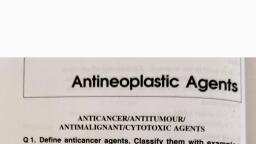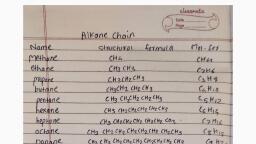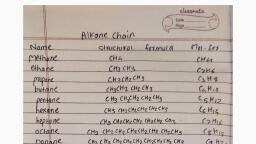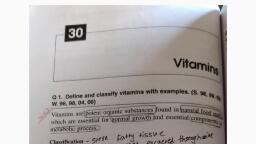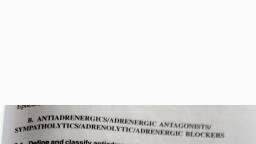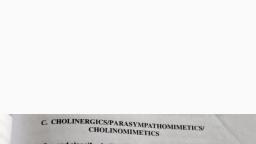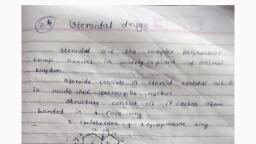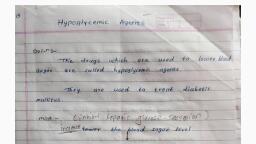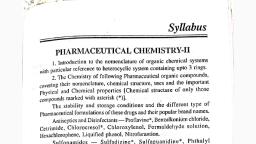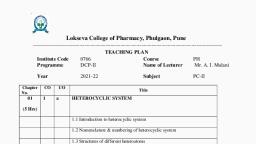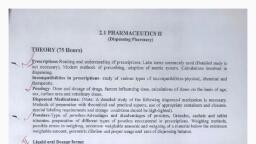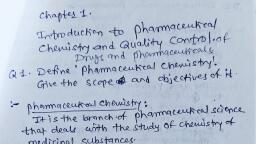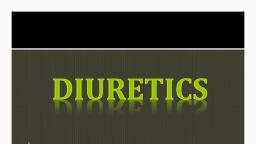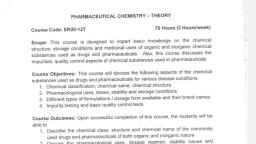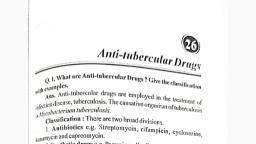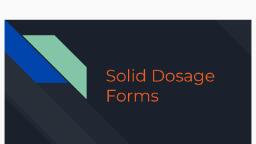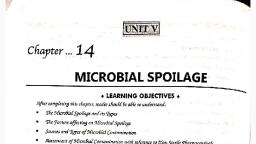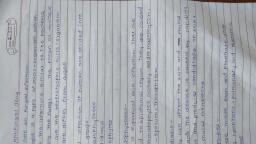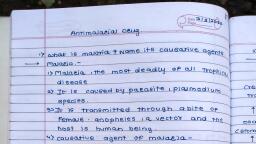Page 1 :
23..., Chapter 23, Diagnostic Agents, Diagnostic agents are the compounds used to detect impaired function of the, hody organs or to detect abnormalities in tissue structure. Usually they have no, therapeutic value. The diagnostic agents can be discussed under the following, heads :, 1. Radiopaques (X-ray contrast media), e.g. Propyliodone, lopanic acid., 2. Agents used to test organ functions :, (a) to test kidney function. e.g. Indigotindisulphonate (Indigo carmine)., (b) to test liver function. e.g. Sulphobromophthalein sodium., (c) miscellaneous. e.g. Fluorescein sodium, Evans blue, Congo red., Radiopaque agents have an ability to absorb X-rays and thus are opaque to, (do not allow to pass ) X-ray radiation. Hence, they produce lighter or whiter shadow, on X-ray film (called roentogenographic examination) and darker shadows on, fluoroscopic screen (called fluoroscopic examination) of the organs to be visualised., In 1924, Iodine was observed to be opaque to X-rays. Inorganic iodine, compounds which are ionised, are generally toxic. However iodinated organic, compounds which contain iodine bonded covalently with carbon, do not release, lodide ions readily and hence are less toxic., The iodinated organic compounds are administered primarily by two, techniques :, 1. In systemic procedures, the agents are given orally or intravenously. They are, used in urography (to examine kidney) or cholecystography (to examine gall, bladder). The contrast medium is used for roentgenographic visualisation of, the parts of body which are accessible like alimentary canal, urinary tract,, biliary tract, blood vessels etc., 2. In retrograde procedures, the agents are introduced by mechanical means, e.g. when the drug is introduced by catheter directly into urinary tract, through ureteral orifice then it is called retrograde pyelography., The radiopaque agents (contrast media) may be divided into two categories., 1. Water soluble constrast media : This may contain pharmaceutical buffer, like phosphate or citrate buffer and a sequestering agent. They are mainly, used for urography (examination of ureter, kidney) and angiography, (examination of arterial system). It is also used for visualisation of heart,, Lymph and bile ducts. In this, first patients are tested for sensitivity before, administration of drug., (23.1), 287/305, Scanned with CamScanner, Scanned by TapScanner
Page 2 :
Diagnostic Agents, Concise Organic Pharmaceutical Chemistry -II, 23.2, 2. Water insoluble contrast media : The agents are practically insoluble in, water and hence their suspensions are prepared. They are mainly used for, cholecystography (examination of liver, gall bladder) and sometimes, bronchography (examination of bronchial tract) and myelography. The patient, is not allowed to eat or drink atleast six hours before the examination., 1. PROPYLIODONE, It is propyl acetate derivative in which the hydrogen atom of a-carbon atom is, replaced by 3, 5 diodo, 4-oxo, 1, 4-dihydropyridin-1-yl group., Properties, It is white crystalline powder and is odourless. It is very slightly soluble in water., When it is heated with conc. sulphuric acid, violet vapours of iodine are evolved., Storage :, It is stored in well-closed, light-resistant containers., Uses :, It is a contrast medium used Iin bronchography (as it is rapidly eliminated from, lungs)., Dosage forms :, 1: Propyliodone injection., 2. Propyliodone oily injection., Brand name : Dionosil., 2. IOPANOIC ACID, It is a butyric acid derivative in which H atom of a carbon is réplaced by, 3-amino, 2, 4, 6-tri-lodo benzyl group., Properties :, It is white or cream coloured powder which is odourless and almost tasteless., When it is heated strongly, violet vapours of lodine are produced., Due to presence of aromatic primary amino group, it undergoes diazotişation and, coupling reaction to give deep orange red precipitate., Storage :, It is stored in well-closed, light-resistant containers., Uses :, It is used as a contrast medium in radiography of gall bladder (as it is excreted in, bile on oral administration)., Dosage form :, Iopanoic acid tablets., Brand name : Telepaque., Scanned with CamScanner, Scanned by TapScanner
Page 3 :
Concise Organic Pharmaceutical Chemistry-II, 3. SULPHOBROMOPHTHALEIN SODIUM, It is hygroscopic and hence is stored in tightly-closed containers., It is a white crystalline powder which is odourless and has a bitter taste. It is, soluble in water but practically insoluble in alcohol., 23.3, Diagnostic Agents, Properties :, Stability and storage :, Uses :, is used to test functional capacity of liver particularly its reticuloendothelial, olls (Liver, functioning normal, retains 7% dye in blood after 45 minutes)., Dosage form :, Sulphobromophthalein injection., 4. INDIGOTINDISULFONATE (INDIGO CARMINE), Properties :, It is indoline-5-sulphonate derivative. It is dusky, purpulish blue powder or blue, granules with a coppery lustre. It is sparingly soluble in water. The aqueous solution, gives blue or bluish purple colour., Stability and storage :, It is affected by light. Hence it is stored in well-closed, light-resistant containers., Uses :, It is used :, 1. To test kidney function., 2. To localise ureteral orifices during ureteral catheterisation and cystoscopy., 3. To identify several ureters fistulous communications., Dosage form :, Indigotindisulfonate injection., Brand name : Indigo carmine., 5. EVANS BLUE (AZOVAN BLUE), It is an azo dye and is 5-hydroxynaphthalene 1, 3-disulphonate derivative., Properties :, It is green or bluish green or brown powder and is odourless. It is very soluble in, water but very slightly soluble in alcohol., Stability and storage :, In dry form it is hygroscopic. Hence, it is stored in tightly-closed containers., Uses :, It is used as a diagnostic agent to determine blood volume., Dosage form :, Evans blue injection., 6. CONGO RED, It is an azo dye and is 4-amino naphthalene-1-sulphonate derivative., Properties :, It is dark red or reddish brown powder and is odourless. It is soluble in water., It decomposes on exposure to fumes of mineral acids., Scanned by TapScanner
Page 4 :
Concise Organic Pharmaceutical Chemlstry -II, Diagnostic Agents, 23.4, Stability and storage :, It is stored in well-closed containers., Uses :, To detect amyloidosis (condition in which there is deposition of amyloid in, tissues) e.g. in liver, kidney etc., Dosage form : Congo red injection., 7. FLUORESCEIN SODIUM, It is a Xanthene derivative., Properties :, It is an orange-red powder which is odourless and aimost tasteless. It is freely, soluble in water. It fluoresces strongly even in dilute solution. The fluorescence, disappears on acidification and reappears when solution is made alkaline., Stability and storage :, It is hygroscopic and hence it is stored in tightly-closed containers., Uses :, 1. In opthalmic practice, it is used as diagnostic agent for detecting lesions and, foreign bodies. (Normal cornea is not stained by 2% solution. However ulcers., or abraded area becomes green and foreign bodies are seen surrounded by, green ring.), 2. 5 to 20% solution is used intravenously :, (a) for investigation of circulatory disorders., (b) for differentlation of normal and malignant tissues when examined in u.v., light., QUESTIONS, 1. What are diagnostic agents ? Give a brief account of radiopaques., 2. Give properties, uses and dosage forms of, (a) Propyliodone, (b) Indigotindisulfonate, (c) Evans blue., 3. Give properties, stablity, storage and uses of the diagnostic agents which, contain the following chemical features., (a) Xanthene derivative, (b) Indoline derivative, (c) Amino-naphthalene derivative., 4. Write a short note on diagnostic agents., [4], [6], [6], [6], Scanned with CamScanner, Scanned by TapScanner

